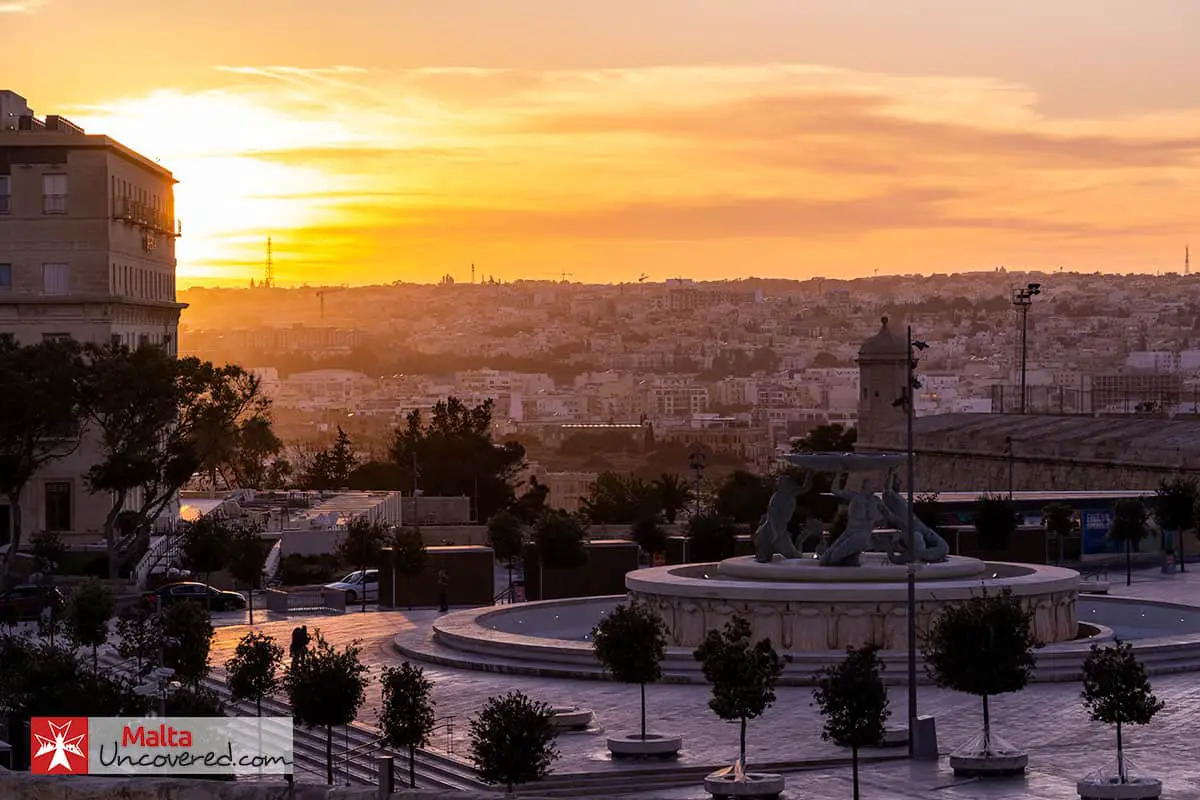Home » Malta island » The weather » Malta in November
Visiting Malta in November can be a great opportunity to enjoy mild weather in Malta, with daytime temperatures averaging 15-20°C (59-68°F). That makes the climate ideal for exploring the island’s rich history and natural beauty. It may be a little too cold to swim for most at this time of year, but it’s perfect for outdoor activities, avoiding the hot summer weather.
November is the month in which the locals in Malta might experience the first few cold days after the warm season. As is typical with the weather in the Maltese islands, the sun will likely still be shining, but temperatures will start to drop. Shorter days with fewer daylight hours mean evenings may get chilly, so you’re better off packing layers for clothes.
At the same time, students and workers will be working hard before the Christmas season rolls around, with few visitors coming to Malta due to similar reasons. This means visiting in November is likely to mean you experience quiet and uncrowded sites and locales, with pleasant sunshine although slightly colder temperatures.
While November is far from being considered a “cold” month of the year, it’s normal for temperatures to start dropping around this time. Usually, early November is characterised by some hot days that locals refer to as ‘the summer of St Martin’ (after the Saint whose feast is celebrated at the start of the month). This essentially means that the first few weeks of November will be those of an Indian summer.
November weather typically starts to cool down from mid-month onwards, with certain days being uncharacteristically wet, windy, and cold. Don’t worry, though. The temperatures are far from settling down, and it’s very normal to have a cold spell with rainy days followed by ones that are sunny and warm.
The most important thing when visiting Malta in November is that you’re prepared for extremes of weather, expecting both sunshine and rain. Furthermore, strong winds blowing from over the Sahara desert are frequent, bringing with them dust and sand, covering streets, cars, and buildings in a coating of brown dust.
On average, November Malta weather temperatures tend to range between 15-20o C (59-68o F), with sea temperatures being around 22o C (72o F) and rainfall around 75.7mm. Days also tend to be quite short, with around 6.5 hours of sunshine expected.
Somewhat. Early November Malta weather brings with it an ‘Indian summer’, meaning that the warm temperatures and hot sunshine will probably be the case. However, the weather can suddenly change without warning. These colder spells usually hit towards the end of the month, with days gradually becoming a bit windy, but this can be followed by more days of warmth.
Evenings tend to be much cooler than the daylight hours, with cool breezes being rather a common phenomenon. On the other hand, humidity levels are high, as tends to be the case in Malta. This makes for the relatively cooler temperatures to feel much colder than you would expect them to feel.
While the sea is not yet freezing cold, the temperature of the water is definitely much colder and only the bravest venture in for a swim during this time. If you intend to do so, be aware that underwater currents might make for a very strong sea. In fact, locals tend to avoid swimming during this time of year. It’s usually wise to follow the local’s examples as they are well accustomed to the temperamental weather.
It’s important to also be aware that rainfall in Malta is quite different from that in typically wet countries. Here, rain tends to come down in torrents, not drizzles, flooding low-lying areas. It’s common for strong rainfall to complicate or completely stop some activities.
Keep this in mind if your plans are going to take you through easily flooded areas, such as Birkirkara, Balzan, Msida and Qormi. These areas lie in valleys, through which nature has always channelled rainwater into the sea. Tarmacked roads make the flow of rainwater a lot more dangerous than a natural landscape would, and the local authorities have not yet managed to improve the situation much over the past decades.
Yes, the sun typically shines in November. Of course, its strength is a lot less than that of the summer months; however, it can get rather warm. You’ll likely get a good number of warm and sunny days.
However, do keep in mind that the November Malta weather is particularly temperamental and can suddenly change to being cold, grey, windy, and very wet.

Check out my two guidebooks full of local knowledge and my best recommendations for your trip, and up-to-date for 2024!
Malta & Gozo guide book
Valletta: An Insider’s Guide to Malta’s Capital
Take the hassle out of planning your trip to Malta and be an informed traveller!
November is a pretty quiet month in Malta. Locals are busy with day-to-day activities such as work, school, and night-time activities. This leaves very little time for them to be enjoying themselves during the week. However, from Friday night to Sunday, many places fill up with revellers.
You’re more likely to come across groups of schoolchildren at historical sites and museums. On the other hand, restaurants, bars, and shops will be filled with people on their lunch break or running errands on their day off.
Of course, you also won’t have to worry much about facing crowds of visitors to the island as the number of tourists is greatly decreased during this time. Nonetheless, social and cultural activities are still held throughout the month, so you’ll be able to enjoy a number of fun events.
Furthermore, thanks to the more frequent rainy days and milder sunshine, the countryside will become greener again, offering a lovely background for walks and hikes.
Yes, November is a great time for visiting Malta, as long as you don’t mind the possibility of sudden weather changes and the unlikelihood that you’ll be able to enjoy too many outdoor activities.
The Maltese social calendar is brimming with events all year round. You can expect to find something going on in November, most often some annual event or other that locals await eagerly. However, if you’re more into smaller activities, you can always look into going on a guided tour. Alternatively, you’ll also find many fun activities to do around Malta.
If you’re considering going on sightseeing tours while you’re visiting, there are a couple that are well suited for this time of year:
TIP: Use coupon code MALTA5 for 5% off at Yippee!
Get my recommendations on the best day trips, boat trips, excursions and activities and book in advance!

A relatively new event, this festival celebrates history, culture, and music with artistic performances set against historically significant buildings in the three cities. Apart from musical performances, theatre and dance artists also showcase their talents for a truly beautiful event.
Lovers of string music, particularly piano and organs, will rejoice at this yearly event. World-renowned organists will play beautiful melodies on the various organs found at the churches, basilicas, and cathedrals around Malta and Gozo. The festival aims to promote classical music against a vast cultural heritage left by our forefathers.
An annual and beloved event aimed specifically at children and youths, ŻiguŻajg offers a fantastic line-up of local and foreign artists that put on various wonderful shows.
From dramatic performances, comedy sketches, circus acts, puppet shows, music theatre, and even film screenings, there is something for everyone in the family to enjoy. Apart from this, several workshops revolving around different activities are held, with participation costing only a very small fee (around €2)
Held in Valletta every year, this event is one that many bookworms await with anticipation. The festival includes a family-friendly programme of activities that celebrate the wonder of books through book launches, presentations, readings, dramatisations, conferences, seminars, and meet-and-greets with authors.
Both local and foreign authors participate by exhibiting or holding discussions about various interesting literary topics, with even some stand-up comedians joining in the fun. A great event for literature enthusiasts and book lovers alike.
While not strictly an event held just in November, Festival Mediterranea commemorates 7000 years of history and culture in Malta’s sister island, Gozo. The event celebrates Gozo’s culture and art scene between October and December, offering visitors the opportunity to attend lectures, talks, and tours about some of the island’s historic hotspots.
Each year, the programme of events varies and organisers try to incorporate as much as possible of Gozo’s charm, mythology, culture, art, and history. You can attend opera, and symphonic music performances, sample traditional cuisine, watch folk performances, learn about archaeology, and appreciate Gozitan creativity. Definitely not an event to be missed!
Looking for more? Check out my list of annual events in Malta/Gozo.
Sudden changes in the weather in Malta and temperature mean that swimming in November isn’t guaranteed. While the temperature of the water is far from freezing, wind days, grey skies, and strong undercurrents may make time at the beach difficult.
However, on beautiful sunny days, many locals venture out for a quick dip, some fishing, or even gentle sunbathing. Activities really depend on the weather of the day. Nonetheless, it’s unlikely you will find large crowds at the beach during this time, and no lifeguards, umbrellas, deckchairs, or water sports activities are available.
Fortunately, less-than-stellar beach conditions can be worked around by going to specific bays, depending on the wind direction. Keep in mind that beaches in the North of Malta tend to be sandy, while those in the South are rockier.
If you’re looking for a change in activities from day tours and organised events, you can always look into having some quiet fun on your own. Here’s a shortlist with some ideas:
Looking for inspiration on how to plan your trip to Malta? Consult my tried-and-tested Malta itineraries:
Finding a nice place to stay on your visit to Malta in November should be pretty easy. This month falls directly between the summer season and the Christmas season, meaning very few people will be coming over for a visit. Due to this, many places of accommodation should be available. Some of the types of accommodation you can book include the following:
The silver lining of fewer tourists is also that many hotels, bed and breakfasts, and AirBnBs offer special deals during this time.
Along with deciding on the best accommodation that suits you best, you also need to keep in mind how you’d like to spend your time during your holiday.
If you’re looking to visit many historical sites, cultural venues, museums and several quaint narrow streets filled with many stories of the past, I suggest staying in the capital, Valletta. The city is the hub of culture and history and also offers the convenience of the main bus terminus with public transport leading to most Maltese towns and villages. You’ll also have the benefit of various shops, restaurants, pubs, bars, and other entertainment venues.
Alternatively, if you’re looking for more shopping opportunities, delicious upper-scale food, and interesting cocktail fusions, the best places to stay would be around Sliema, St Julian’s, Msida, Ta’ Xbiex, and Gżira. These spots are the most popular with tourists and expats alike, making them popular commercial and entertainment centres.
Quieter options to experience a more local way of life would be villages like Mellieħa, Buġibba, St Paul’s Bay, and Qawra in the North, or Marsascala, Birżebbuġa, Xgħajra, and Marsaxlokk in the South. Here, you’ll also have more options for AirBnBs and boutique hotels, oftentimes close to a more rural setting.
Apart from that, staying in Malta’s sister island—Gozo, is always a great choice. If you’re especially looking for a quiet, traditional Mediterranean lifestyle for your break, then this is the place for you. Several people, including locals, choose to make a quick getaway from the hustle and bustle of daily life by renting a private farmhouse to ensure maximum quiet relaxation and absolutely stunning views of the Gozitan countryside.
You can find more info on this topic here: Where to Stay in Malta.
Leave a comment below and I’ll get back to you with an answer shortly!

Edward is the Founder and Editor of Malta Uncovered and author of two guidebooks on Malta and Valletta.
As a tourist-turned-expat with Maltese roots, he knows the islands inside out and helps thousands of visitors enjoy a memorable trip every year.
Get the best travel tips from Malta Uncovered delivered to you in bite-sized chunks by email. (Unsubscribe at any time!)
Was this article helpful? Share it with your friends!
Get the most out of your visit to Malta with Malta Uncovered guidebooks – full of local knowledge and up-to-date for 2024!
